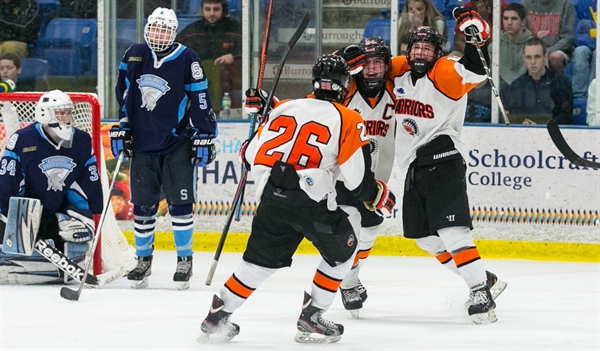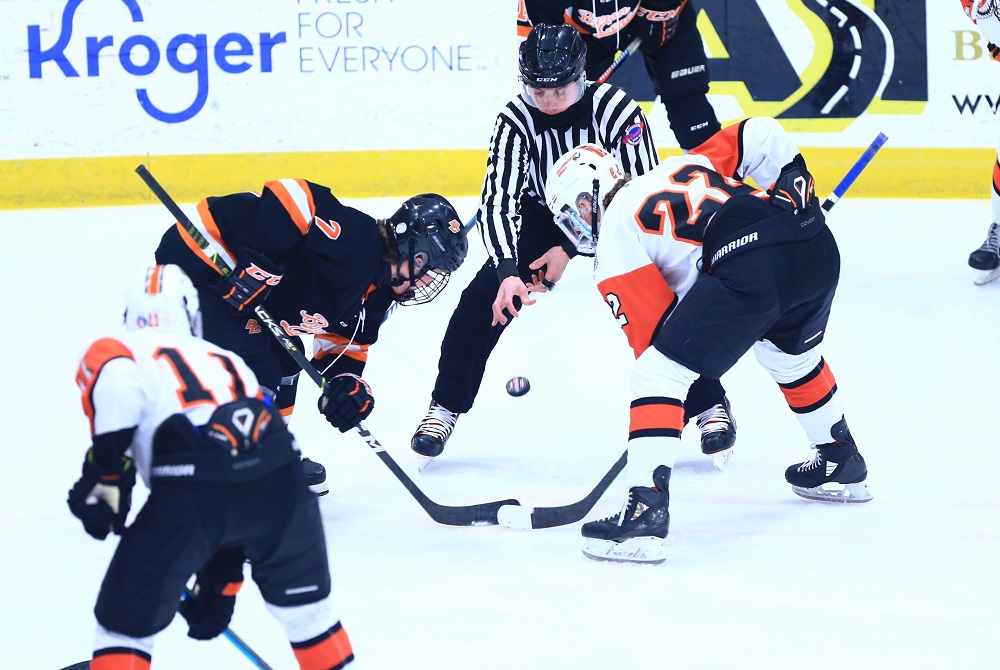
Manning Up for Brother Rice Title Run
March 14, 2015
By Bill Khan
Special for Second Half
PLYMOUTH — For Matt Manning, there were no hard feelings.
From his standpoint, it was a clean hockey play, even though a penalty was called on his opponent.
He just happened to be on the wrong end of a devastating hit that nearly deprived him of his senior season at Birmingham Brother Rice and the opportunity to lead his team to an MHSAA championship.
In a scrimmage on Nov. 17, two days before the season opener against Livonia Stevenson, Manning was forechecking on a penalty kill when he got the puck and slipped it behind a defender. With his head down as he was chasing the puck, Manning never saw what was coming.
"This kid just came from my blind side," the 5-foot-6 Manning recalls. "He got me in the right spot. He was a lot bigger than me. He won that battle."
But Manning and his teammates were the ultimate winners Saturday. He was in the stands as a freshman when Brother Rice won its last MHSAA title, in 2012, but was a key reason why the Warriors won their fourth with a 6-3 victory over Livonia Stevenson at Compuware Ice Arena.
Manning didn't immediately realize he was injured back in November, but he felt sharp pain when he tried to move his left arm on his way back to the bench. His left collarbone had been broken in half, an injury that required a plate and seven screws to repair.
Manning experienced some dark days in the immediate aftermath of the injury.
"It killed my confidence, basically, because we were just starting the season," he said. "We hadn't played our first game. It was the first scrimmage, the third shift. I was getting down about it. After that, and getting through the therapy, realizing it was going to get better with all the sessions we had, it just got much better a lot quicker."
Manning was back in the lineup on Jan. 7, adding a high-end talent to a team already ranked No. 1 in Division 2.
Manning had only one assist Saturday, but makes an impact as a tenacious, high-energy forechecker that isn't always quantified on the scoresheet. Stevenson coach David Mitchell agreed that Manning's presence was a huge plus for Brother Rice, which beat Stevenson 4-3 in the teams' season opener on Nov. 19 in Livonia.
 "You saw some things around the net today where he made plays that were special hockey plays," Mitchell said. "It's tough playing an opponent like him, but I'm thrilled he's in high school hockey and he's helping high school hockey grow. Having a player like that in our game makes our game better and makes the level of competition better for everybody and more enjoyable for people to watch."
"You saw some things around the net today where he made plays that were special hockey plays," Mitchell said. "It's tough playing an opponent like him, but I'm thrilled he's in high school hockey and he's helping high school hockey grow. Having a player like that in our game makes our game better and makes the level of competition better for everybody and more enjoyable for people to watch."
Brother Rice coach Lou Schmidt, in his 12th year with the Warriors, said Manning's comeback from a major injury was remarkable.
"I've never in my years seen anybody come back like he did," Schmidt said. "Usually, there's this very cautionary period where you don't want to get hit. He started skating five weeks after the injury; you never would've known he was out. He was a huge addition to our team. He made us deeper, he made us better."
Brother Rice wouldn't have had the opportunity to play for the title on Saturday had Manning not scored on a backhander 25 seconds into the fourth overtime to give the Warriors a 4-3 victory over Hartland in the Quarterfinals on Tuesday. It was one of two one-goal victories for the Warriors on their march to the championship.
Although Brother Rice won by three goals, the Warriors found themselves in another tough battle against a Stevenson team that was two years removed from an MHSAA championship.
Brother Rice dominated the early going, outshooting Stevenson 10-2 in the first period and taking a 2-0 lead just 53 seconds into the second period on a goal by Joey Vassallo.
The Warriors swarmed the Spartans' net after that in search of a knockout blow, only to be thwarted by junior goalie Cullen Barber.
After going without a shot on its first two power plays, Stevenson injected some life into the building when Alex Allen scored on the power play at 8:41 of the second period. The Spartans quickly tied it when Joe Alcantara scored at the 10:36 mark.
"I'm so proud of our guys," Mitchell said. "I think everybody saw it had the potential to get away when it was 2-0 and they were still carrying the play. But like we did all year, we answered back and made a game of it, which was great not only for us, but for the game of high school hockey. That second period was exciting. It's good that it was a good, solid hockey game that I hope did high school hockey proud."
Brother Rice regrouped and regained its two-goal lead on goals by Brendan Pyc at the 12:58 and 16:19 marks of the second.
"It was a big momentum shift when they scored their first one," said Brother Rice senior Nick Rosa, the only player remaining from the 2012 championship team. "When they got the second one, we knew we had to get the next one; that was big."
Stevenson got back within striking distance when Vince Glenn scored on the power play 44 seconds into the third period. Rosa's team-leading 25th goal of the year with 8:58 remaining in the game re-established Brother Rice's two-goal cushion.
Stevenson failed to click on two late power plays before the Warriors put an exclamation point on the championship with an empty-net goal by Jack Dansbury with 20.3 seconds to go.
"It's the longest journey ever," Rosa said. "Nine months ago, we started working out in the summer five days a week. We never stopped. This was our ultimate goal. We achieved it. Every day we came to practice and tried our best. I'm really proud of the boys."
Brother Rice was 3 for 4 on the power play, while Stevenson was 2 for 6.
"It was a special teams kind of day," Schmidt said. "We played well when we had to. We made it interesting there in the second — maybe for the fans, but not so much for the coaches."
PHOTOS: (Top) Brother Rice celebrates one of six goals Saturday against Livonia Stevenson. (Middle) Stevenson’s Nate Sudek drives into the Warriors’ zone during the Division 2 Final. (Photos by Andrew Knapik/Southgate).

Be the Referee: Hockey Delayed Offside
By
Brent Rice
MHSAA Assistant Director
February 16, 2022
Be The Referee is a series of short messages designed to help educate people on the rules of different sports, to help them better understand the art of officiating, and to recruit officials.
Below is this week's segment – Hockey Delayed Offside - Listen
Bundle up because we are on the ice today with a delayed offside situation in hockey.
During the delayed offsides, the puck is shot directly on goal. Should the official:
► Whistle the play dead and restart with a faceoff from the offending team zone?
► Whistle the play dead and restart with a faceoff from the closest dot from where the shot was taken?
► Whistle the play dead and restart with a faceoff from the neutral zone?
► Or – let the play continue.
If you said let the play continue, you are correct. In this situation, the play should be allowed to continue until all offensive players clear the offensive zone.
The next time there’s a delayed offsides call with a shot on goal, you’ll know what to do.
Previous editions
Feb. 10: Basketball Timeout - Listen
Feb. 3: Basketball Video Review - Listen
Jan. 27: Wrestling Inspections - Listen
Dec. 16: Ball Over Backboard - Listen
Dec. 9: Winter Officials Mechanics - Listen
Nov. 26: Instant Replay - Listen
Nov. 11: Tourney Selection - Listen
Nov. 4: Receiver Carried Out of End Zone – Listen
Oct. 28: Volleyball Back-Row Block – Listen
Oct. 21: Soccer Disallowed Goal – Listen
Sept 30: Field Goal Falls Short – Listen
Sept. 23: Volleyball Obstruction – Listen
Sept. 16: Catch or No Catch – Listen
Sept. 9: Intentional Grounding – Listen
Sept. 2: Pass Interference – Listen
Aug. 26: Protocols and Mechanics – Listen

